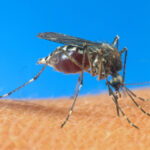Key Facts
- Eastern Equine Encephalitis (EEE) is passed to humans by infected mosquitoes.
- Anyone who lives in an area where EEE has been reported is at risk.
- The best way to lessen your risk is to avoid getting bitten by mosquitoes: see full guide.
 If you live in an area where there have been cases of the Eastern Equine Encephalitis virus (EEEV), you may have heard about it on the news. Although it is rare, EEE is very serious. People who are infected with the EEEV become very sick and can die of complications; however, there are things you can do to protect yourself.
If you live in an area where there have been cases of the Eastern Equine Encephalitis virus (EEEV), you may have heard about it on the news. Although it is rare, EEE is very serious. People who are infected with the EEEV become very sick and can die of complications; however, there are things you can do to protect yourself.
What is EEE?
EEE stands for Eastern Equine Encephalitis, also known as “Triple E.” You can’t get EEE from another person. It’s a virus that is caused by an infected mosquito. The infected mosquito has to bite a person to infect them. However, not all mosquitoes carry EEE. The ones that do are found in certain areas.
Who is a risk for getting EEEV?
- Anyone who lives in an area where the EEEV has been reported
- People who spend a lot of time outside especially in wooded or swampy areas
- People that have chronic health conditions and/or a weak immune system
What are the symptoms of EEEV?
Symptoms usually start about 4-10 days after being bitten by an infected mosquito.
- High fever and chills
- Headache
- Feeling very tired
- Nausea and vomiting- (feeling like you need to throw up or throwing up)
- Stiff neck
- Eyes are sensitive to light
Advanced symptoms/Signs of brain inflammation (Encephalitis):
- Seizures
- Confusion
- Coma
How can I protect myself from EEE?
The best way to lower your risk of getting EEEV is to avoid getting bitten by mosquitos.
- Use an insect repellant with either DEET, IR3535 or oil of lemon eucalyptus
- Wear clothes such long pants and long-sleeved shirts when you’re outside
- Try not to spend time outside when mosquitoes are biting- particularly late afternoon to early morning
- Stay away from areas that have “stagnant water” or puddles of water where mosquitoes live; empty buckets, bird baths or other containers with open water which are breeding places for mosquitoes
What else should I know about EEE?
Other medical conditions can cause similar symptoms as EEE, that’s why it’s important to talk to your health care provider whenever you’re feeling sick or have a fever, bad headache, nausea and vomiting or other symptoms such as feeling very tired or not like yourself.
Read more about EEE: https://www.cdc.gov/easternequineencephalitis/index.html
Information about recommended insect repellants: https://www.epa.gov/insect-repellents
Our health guides are developed through a systematic, rigorous process to ensure accuracy, reliability, and trustworthiness. Written and reviewed by experienced healthcare clinicians from Boston Children's Hospital, a Harvard Medical School teaching hospital and consistently ranked as a top hospital by Newsweek and U.S. News & World Report, these guides combine clinical expertise, specialized knowledge, and evidence-based medicine. We also incorporate research and best practices from authoritative sources such as the CDC, NIH, PubMed, top medical journals, and UpToDate.com. Clinical specialists and subject matter experts review and edit each guide, reinforcing our commitment to high-quality, factual, scientifically accurate health information for young people.
